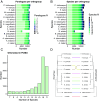Repeated global adaptation across plant species
- PMID: 39705310
- PMCID: PMC11670234
- DOI: 10.1073/pnas.2406832121
Repeated global adaptation across plant species
Abstract
Global adaptation occurs when all populations of a species undergo selection toward a common optimum. This can occur by a hard selective sweep with the emergence of a new globally advantageous allele that spreads throughout a species' natural range until reaching fixation. This evolutionary process leaves a temporary trace in the region affected, which is detectable using population genomic methods. While selective sweeps have been identified in many species, there have been few comparative and systematic studies of the genes involved in global adaptation. Building upon recent findings showing repeated genetic basis of local adaptation across independent populations and species, we asked whether certain genes play a more significant role in driving global adaptation across plant species. To address this question, we scanned the genomes of 17 plant species to identify signals of repeated global selective sweeps. Despite the substantial evolutionary distance between the species analyzed, we identified several gene families with strong evidence of repeated positive selection. These gene families tend to be enriched for reduced pleiotropy, consistent with predictions from Fisher's evolutionary model and the cost of complexity hypothesis. We also found that genes with repeated sweeps exhibit elevated levels of gene duplication. Our findings contrast with recent observations of increased pleiotropy in genes driving local adaptation, consistent with predictions based on the theory of migration-selection balance.
Keywords: global adaptation; plant genomics; pleiotropy; repeated adaptation; selective sweep.
Conflict of interest statement
Competing interests statement:The authors declare no competing interest.
Figures




References
-
- Flood P. J., Hancock A. M., The genomic basis of adaptation in plants. Curr. Opin. Plant Biol. 36, 88–94 (2017). - PubMed
-
- Hereford J., A quantitative survey of local adaptation and fitness trade-offs. Am. Nat. 173, 579–588 (2009). - PubMed
-
- Sanford E., Kelly M. W., Local adaptation in marine invertebrates. Annu. Rev. Mar. Sci. 3, 509–535 (2011). - PubMed
-
- Savolainen O., Lascoux M., Merilä J., Ecological genomics of local adaptation. Nat. Rev. Genet. 14, 807–820 (2013). - PubMed
-
- Savolainen O., Pyhäjärvi T., Knürr T., Gene flow and local adaptation in trees. Annu. Rev. Ecol. Evol. Syst. 38, 595–619 (2007).
MeSH terms
Grants and funding
LinkOut - more resources
Full Text Sources

